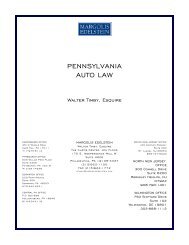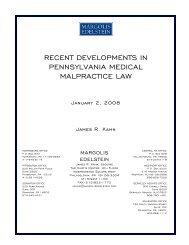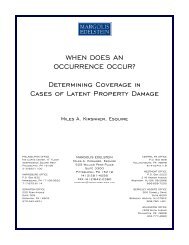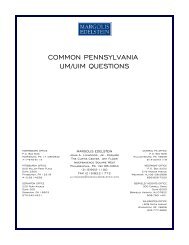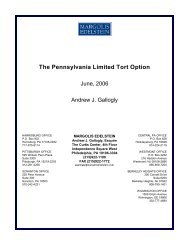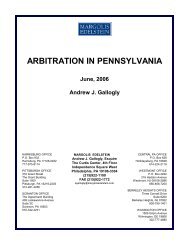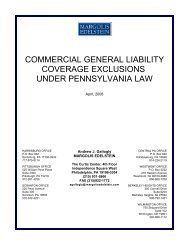selected topics in pennsylvania legal malpractice law - Margolis ...
selected topics in pennsylvania legal malpractice law - Margolis ...
selected topics in pennsylvania legal malpractice law - Margolis ...
Create successful ePaper yourself
Turn your PDF publications into a flip-book with our unique Google optimized e-Paper software.
Pennsylvania <strong>law</strong> provides that the occurrence rule is used to determ<strong>in</strong>e when the statute of<br />
limitations beg<strong>in</strong>s to run <strong>in</strong> a <strong>legal</strong> <strong>malpractice</strong> action. Under the occurrence rule, the statutory<br />
period commences upon the happen<strong>in</strong>g of the alleged breach of duty. Bailey v. Tucker, 533 Pa.<br />
237, 621 A.2d 108 (1993). The trigger for the accrual of a <strong>legal</strong> <strong>malpractice</strong> action is not the<br />
realization of actual loss but the occurrence of a breach of duty. Under the “occurrence rule” the<br />
time the statutory period commences upon the happen<strong>in</strong>g of the alleged breach of duty. Wachovia<br />
Bank, N.A., supra.<br />
Pennsylvania favors strict application of the statutes of limitation and public policy<br />
considerations do not warrant toll<strong>in</strong>g of statute of limitations on <strong>legal</strong> <strong>malpractice</strong> action past the<br />
time the client could have reasonably been aware of attorney’s breach, despite any dilemma aris<strong>in</strong>g<br />
from possibility that client could potentially have to simultaneously litigate underly<strong>in</strong>g case and<br />
prosecute <strong>legal</strong> <strong>malpractice</strong> premised on the underly<strong>in</strong>g claim, given overrid<strong>in</strong>g public policy of<br />
avoid<strong>in</strong>g stale claims. Wachovia Bank, N.A, supra.<br />
The appeal of the underly<strong>in</strong>g action upon which the claim of <strong>malpractice</strong> is based does not<br />
operate to toll the statute of limitations. Wachovia Bank, N.A. v. Ferretti, 935 A. 2d 565 (Pa.<br />
Super. 2007); Robb<strong>in</strong>s & Seventko v. Geisenberger, 449 Pa. Super 367, 674 A. 2d 244 (1996).<br />
An exception to the occurrence rule is the equitable discovery rule which will be applied<br />
when the <strong>in</strong>jured party is unable, despite the exercise of due diligence, to know of the <strong>in</strong>jury or its<br />
cause. “The po<strong>in</strong>t of time at which the <strong>in</strong>jured party should reasonably be aware that he or she has<br />
suffered an <strong>in</strong>jury is generally an issue of fact to be determ<strong>in</strong>ed by the jury...Only where the facts<br />
are so clear and reasonable m<strong>in</strong>ds cannot differ may the commencement of the limitations period be<br />
determ<strong>in</strong>ed as a matter of <strong>law</strong>.” Knopick v. Connelly, 639 F.3d 600 (3d Cir. 2011); Coregis Ins.<br />
Co. v. Baratta & Fenerty, Ltd., 264 F.3d 302, 307 (3d Cir. 2001) (quot<strong>in</strong>g Sadtler v. Jackson-Cross<br />
Co., 402 Pa. Super. 492, 587 A.2d 727 (1991)).<br />
Accord<strong>in</strong>gly, the statute of limitations <strong>in</strong> a <strong>legal</strong> <strong>malpractice</strong> claim is tolled when the client,<br />
despite the exercise of due diligence, cannot discover the <strong>in</strong>jury or its cause. Robb<strong>in</strong>s & Seventko<br />
v. Geisenberger, 449 Pa. Super 367, 674 A. 2d 244 (1996). The statute will beg<strong>in</strong> to run when the<br />
client is put <strong>in</strong> a position to discover the <strong>in</strong>jury and its cause, either through <strong>in</strong>quiry or retention of<br />
a new <strong>law</strong>yer. Knowledge can also arise when an adverse action is taken aga<strong>in</strong>st the client, either<br />
through a court order or through a third party action. Knopick v. Connelly, 639 F.3d 600 (3d Cir.<br />
2011). However, cont<strong>in</strong>uous representation of a pla<strong>in</strong>tiff does not toll the limitations period.<br />
Glenbrook Leas<strong>in</strong>g Co. v. Beausang, 839 A.2d 437 (Pa. Super. 2003).<br />
The doctr<strong>in</strong>e of fraudulent concealment also serves to estop the defendant from assert<strong>in</strong>g the<br />
bar of the statute of limitations. The doctr<strong>in</strong>e provides that the defendant may not <strong>in</strong>voke the statute<br />
of limitations, if through fraud or affirmative concealment, he causes the pla<strong>in</strong>tiff to relax his<br />
vigilance or deviate from his <strong>in</strong>quiry <strong>in</strong>to the facts. The pla<strong>in</strong>tiff must demonstrate fraud or<br />
concealment by clear, precise and conv<strong>in</strong>c<strong>in</strong>g evidence. While it is for the court to determ<strong>in</strong>e<br />
whether an estoppel results from established facts, it is for the jury to say whether the alleged<br />
remarks constitut<strong>in</strong>g fraud or concealment were made. Glenbrook Leas<strong>in</strong>g Co. v. Beausang, 839<br />
A.2d 437 (Pa. Super. 2003).<br />
-11-



